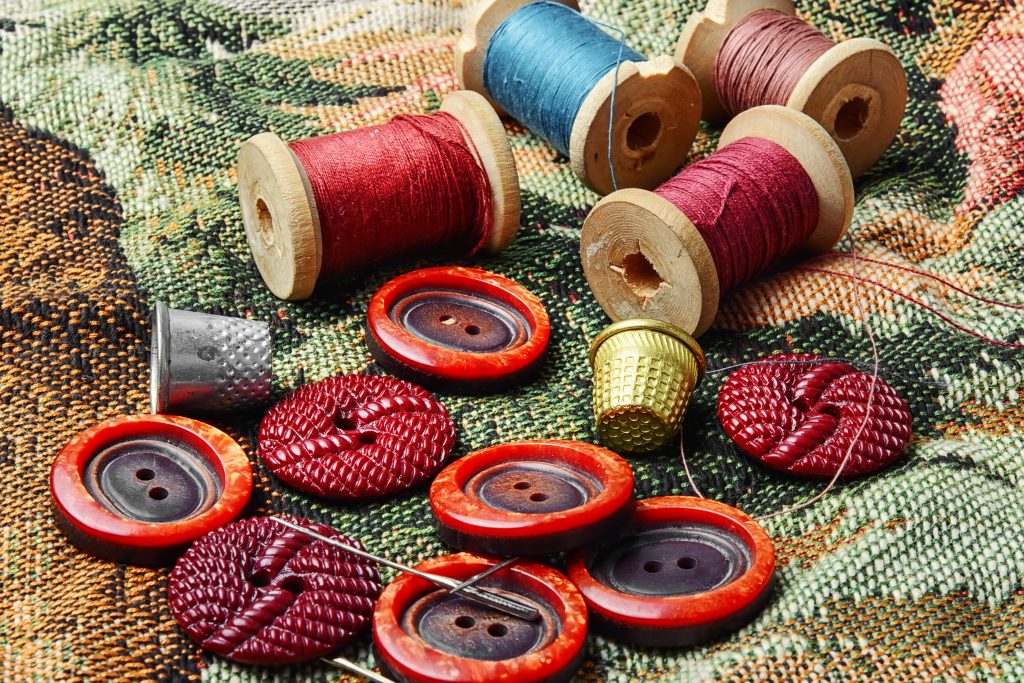National Button Day is celebrated each year on November 16th.
The appeal of buttons is clear. They come in every shape, color and style, from pearly white shirt buttons to ornate Victorian affairs, to cute fastenings shaped like insects and animals. Any outfit can be updated by adding the right buttons, and sewing them on is one of the easiest types of needlework to learn. And they don’t just belong near buttonholes, either. Clusters of buttons can be used to decorate almost everything, and even on their own in jars they are delightful to handle, play with and admire. Some collect them, but most just lose them. Regardless, nearly everyone seems to love them, or at least regard them with fascination.
In case you may be thinking that buttons do not deserve their own holiday, try to imagine what life would be like without them. Sure, we have zippers and velcro, but could you imagine velcro down the front of your elegant blouse? Of course not!
The National Button Society, founded in 1938, established Button Day as a celebration for all who enjoyed collecting and crafting with buttons. Ever since then, Button Day has been celebrated every year on November 16th.
How to Celebrate Button Day
There’s no need to let the buttons on worn-out clothes go to waste! Whenever you can, snip them off, and start a collection this Button Day. In fact, a great place to come across an interesting button is at the thrift shop. You may have to cut them off a given piece of clothing, but when you’re getting something unique for your collection, who really cares? The buttons you collect can be used for many different things, like repairing clothes with missing buttons. But that’s not all! Buttons are an excellent source of craft ideas. You’d be amazed at how many delightfully cute gadgets can be made and/or decorated using buttons, such as picture frames, clocks, purses and bags, headbands, costume jewelry, lamp shades, and even shoes!
When you decorate with buttons, you can be 100% sure that whatever you make will be completely unique, and that nobody else in the world will have the same look as you do. And if you’re not quite feeling up to arts and crafts, remember that buttons can simply be a joy in and of themselves, if even just to look at. Children can enjoy examining buttons as well, but if you do decide to give your button collection to your child to look at, make sure he or she is old enough to know better than to put them in his or her mouth, because neglecting to do that could result in a tragedy.
So take some time on this day to either go though your existing button collection or start a new one, and enjoy Button Day to the fullest! Who knows, perhaps you possess in your collection an antique button that’s been passed down for so long that you’ve never stopped to think about where it came from. Keep your eyes open! Every now and them someone discovers a treasure that had just been sitting around collecting dust at their home. And even if you don’t, an all you have is regular buttons, don’t worry and just enjoy an afternoon looking at the pretty, shiny little things. At the end of the day, people are animals, and there’s nothing animals like better than something pretty and shiny.
NATIONAL BUTTON DAY TIMELINE
The French established the first collective that designed artisan buttons, making buttons a status symbol.
Europe was so button crazy, the church started calling them the “devil’s snare.” This was probably because most women’s clothing of the time buttoned up the front.
Polo players were the first to button down their collars to stop them from getting in the way during a match; Brooks Brothers copied the look and created a lasting trend in 1896.
Noting the abundance of pearl mussels in nearby waters, a German immigrant opened a button-making factory in small town Iowa, which soon grew to be the largest manufacturer of pearl buttons in the world.
A button that was once part of a Texas confederate navy uniform circa the Civil War sold for over $2,000.
3 FACTS TO REALLY PUSH YOUR BUTTONS
-
What side you button up on is gender-based
Women’s clothing traditionally buttons on the right (reportedly because it was easier for maids to dress the ladies they served that way) and men’s on the left (they dressed themselves).
-
Boutonnière means buttonhole in French
Boutonnieres go through a little slit in the lapel of men’s jackets that looks the same as a buttonhole, so we repurposed the French word for buttonhole to describe the flower in English.
-
Buttons on uniform sleeves were put there to stop soldiers from wiping their noses
Widely repeated but never satisfactorily confirmed, it is said that Napoleon ordered brass buttons be placed on the sleeves of all military uniforms so soldiers would be discouraged from wiping their noses on them.


